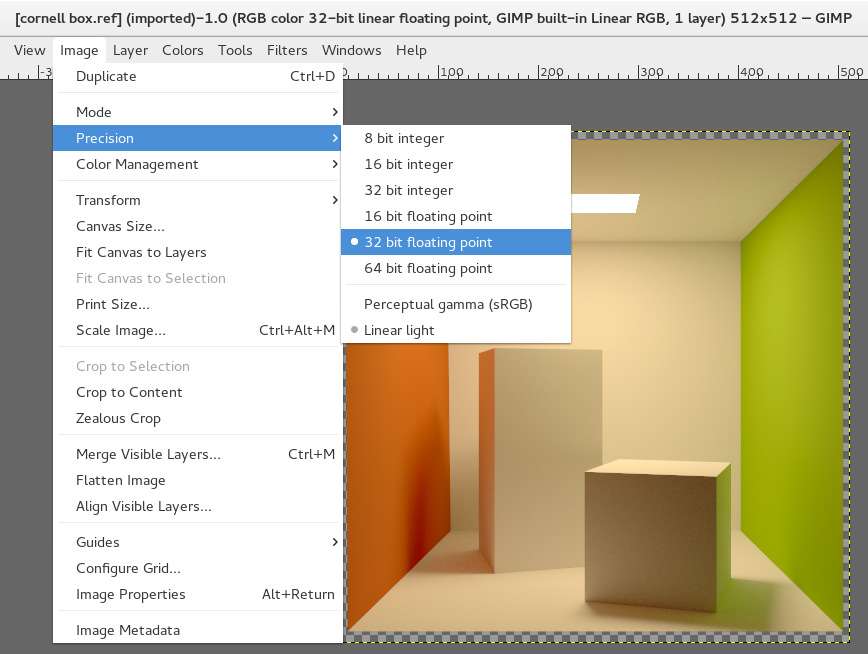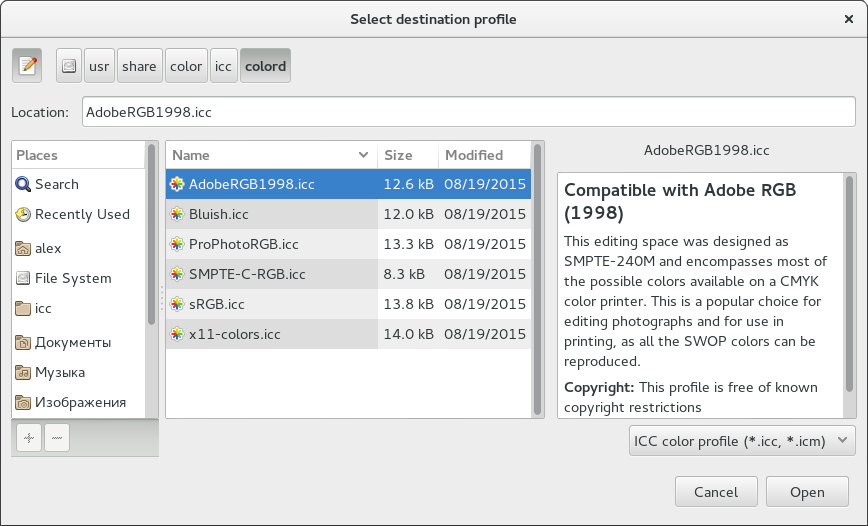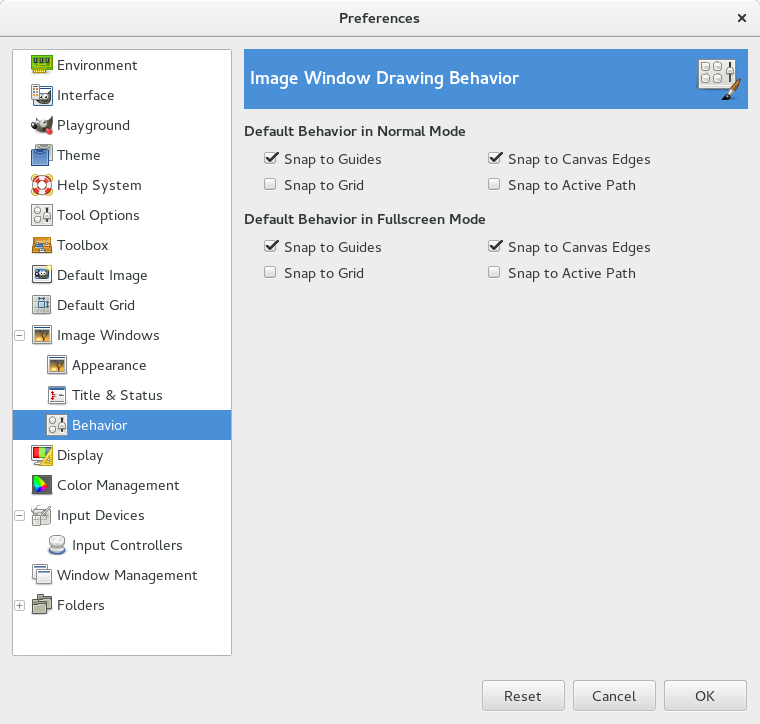We are excited to announce the first development release of GIMP in the 2.9.x series. It is another major milestone towards making GIMP a state-of-the art image editing application for graphic designers, photographers, illustrators, and scientists.
The new version is already available in the Downloads section.
GEGL Port¶
GEGL is GIMP’s new image processing engine. The GEGL project was originally launched in 2000 by several developers from visual effects company Rhythm&Hues who needed a versatile image editor for movie production.
From the very beginning, GEGL was a challenging project, since no general image editing software at the time was built on top of the node compositions concept, and GEGL had to be designed with just that in mind.
In 2007, GIMP developers Sven Neumann, Michael Natterer, and Øyvind Kolås started porting GIMP to use GEGL. However, this process had to be broken up into several stages, because GIMP’s source code was already huge at the time.
So GIMP 2.6 (released in 2008) featured optional use of GEGL-based color grading tools and an experimental tool to use GEGL “filters”. Then GIMP 2.8 (released in 2012) featured GEGL-based projection—flattened representation of stacked layers.
Now upcoming GIMP 2.10 is going to use GEGL for pretty much everything under the hood, and v2.9.2 is the first technical preview release on the way towards v2.10.
While a few advanced features of GEGL such as non-destructive editing are planned to be exposed in GIMP at a later development stage (v3.2 and onwards), with 2.9.2, you can already benefit from certain aspects of the new engine, such as:
- 16/32bit per color channel processing
- Basic OpenEXR support
- On-canvas preview for many filters
- Experimental hardware-accelerated rendering and processing via OpenCL
- Higher-quality downscaling
Additionally, native support for PNG, TIFF, PSD, and FITS files in GIMP has been upgraded to read and write 16/32bit per color channel data.

New and Improved Tools¶
All tools in GIMP are now GEGL-based and fully functional in up to 32bit per color channel precision mode.
GIMP 2.9.2 also introduced two new tools that we consider mostly complete:
- Unified Transform, designed by Peter Sikking and implemented by Mikael Magnusson, combines rotation, scaling, skewing, and adjusting perspective in a single tool.
- Warp Transform, implemented by Michael Muré, replaces the old iWarp plugin and provides its features in a tool that works directly on images, without a preview window.
We have also improved several existing tools:
- Blend tool, worked on by Michael Henning, is now more interactive. After drawing with the tool to define the beginning and the end of the gradient fill, you can adjust start/end positions and change colors.
- Align tool now features vertical and horizontal fill modes thanks to João S. O. Bueno.
- Foreground Select tool can finally make subpixel selections in complex cases such as strays of hair on textured background. Two new masking methods for that were added by Jan Rüegg and Daniel Sabo, and the user interface was updated by Michael Natterer.
Several new experimental tools can be enabled on the Playground page of Preferences dialog:
- N-Point Deformation, by Marek Dvorožňák, implements a new way to bend objects while preserving a natural look.
- Handle Transform, by Johannes Matschke, is an interesting approach at applying scaling, rotating, and perspective correction using handles placed on the canvas.
- Seamless Clone, by Barak Itkin, simplifies merging one image into another by adjusting brightness and colors of the pasted image to match the look of the image it is pasted to.
- MyPaint Brush tool is our first shot at using more brush engines in GIMP. The code was written by Michael Natterer.
All the experimental tools are subject to performance optimizations, bugfixes, user interface redesign etc. We do not guarantee that they will be enabled in v2.10 by default.
File Format Support¶
Thanks to Mukund Sivamaran, Rasmus Hahn, and Øyvind Kolås, GIMP now features basic support for OpenEXR files, both loading and exporting. It’s currently missing advanced features such as layered or multiresolution EXR files, or unpremultiplication when exporting etc., but you should be able to load, process, and export a “regular” floating point EXR file just fine.
Additionally, GIMP 2.9.2 features initial support for WebP images, also both loading and exporting. Missing features so far are ICC profiles, metadata, and animation.
Color Management¶
The color management plugin has been replaced with completely new code by Michael Natterer to provide a more complete set of features, as well as better color fidelity preservation. E.g. GIMP can finally handle cases, when one image is pasted into another, and color spaces don’t match.
GIMP now uses LittleCMS v2 which minimizes color fidelity loss during conversions between 8, 16, 32, and 64bit per channel data, and provides support for ICC v4 color profiles.

There are still some parts of GIMP like color choosers that need to become color-managed. We expect to complete this in time for v2.10.
Layers Blending¶
We have introduced some important changes to blending modes.
Overlay mode is not identical to Soft Light mode anymore and finally relies on a widely used formula from both PDF specification, as well as W3C’s “Compositing and Blending Level 1” spec.
When opening legacy XCF files, GIMP will automatically map the old Overlay mode to the Soft Light during compositing to preserve the rendering of your old artwork. For all newly created layers with Overlay mode the new formula will be used instead.
In addition to HSV-based Hue, Saturation, Chroma, and Value modes GIMP now features their CIE LCH based counterparts: Hue, Chroma, Color, and Lightness. Elle Stone provided a nice example of using them to post-process photos.
Contributors are Rupert Weber, Jörn Meier, Massimo Valentini, Elle Stone, Thomas Manni.
Metadata¶
GIMP 2.9.2 features an experimental dialog to view Exif, XMP, and IPTC metadata—something that we’ve been meaning to provide photographers for quite a while. It doesn’t yet support adding or editing existing metadata—this will be addressed at a later stage of development.
Just like the new color management implementation, metadata support is an integral part of GIMP now.
Digital Painting¶
Apart from the newly added experimental MyPaint Brush tool, there are several major and minor changes:
- Canvas rotation and flipping have been added to facilitate users who need to paint from a different angle or check composition for errors.
- You can optionally lock brush size to zoom.
- All tools that use GIMP’s brush engine now have hardness and force sliders.
The final v2.10 release is expected to feature configurable mirror painting implemented by Jehan Pagès thanks to GIMP users who supported his crowdfunding campaign. The code is mostly complete and will undergo review in the coming weeks.
Configurability¶
To help interested users test experimental features, we added a new Playground page to the Preferences dialog. In v2.9.2, it serves to enable experimental tools that we mentioned earlier in the news.
Behaviour, another new page in the Preferences dialog, helps configuring default snapping in normal and fullscreen modes.

Finally, the user interface to enable and disable tools in the toolbox has moved to the Toolbox page in the Preferences dialog.
Known Issues¶
At this stage, GIMP 2.9.x is mostly very stable and is known to be used in production by some brave users. However, certain image processing operations are currently slow. This has been partially remedied by rendering changes in the viewport first. We expect to do a lot of optimization work later on.
Further Plans¶
We are not planning any epic changes in the next 2.9.x releases. We want to release it as fast as we can, so we will be focusing on wrapping up what we have already started any maybe merging a few feature branches we have.
When GIMP 2.10 is out, we shall focus on the GTK+3 port to provide a more up-to-date user interface and restore rock-solid Wacom support on Windows and OS X.
Following GIMP 3.0 release, we shall start working on non-destructive editing and other much anticipated features.